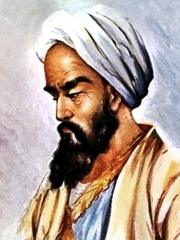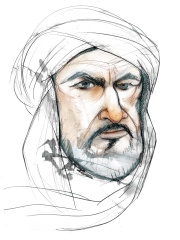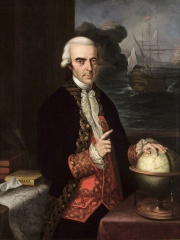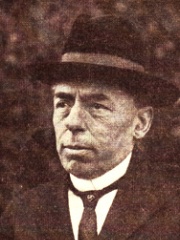





The Most Famous
ASTRONOMERS from Spain
This page contains a list of the greatest Spanish Astronomers. The pantheon dataset contains 644 Astronomers, 7 of which were born in Spain. This makes Spain the birth place of the 19th most number of Astronomers behind Ukraine, and Ireland.
Top 7
The following people are considered by Pantheon to be the most legendary Spanish Astronomers of all time. This list of famous Spanish Astronomers is sorted by HPI (Historical Popularity Index), a metric that aggregates information on a biography's online popularity.

1. Avempace (1080 - 1138)
With an HPI of 75.62, Avempace is the most famous Spanish Astronomer. His biography has been translated into 49 different languages on wikipedia.
Abū Bakr Muḥammad ibn Yaḥyà ibn aṣ-Ṣā’igh at-Tūjībī ibn Bājja (Arabic: أبو بكر محمد بن يحيى بن الصائغ التجيبي بن باجة), known simply as Ibn Bajja (Arabic: ابن باجة) or his Latinized name Avempace (; c. 1085 – 1138), was an Arab polymath, whose writings include works regarding astronomy, physics, and music, as well as philosophy, medicine, botany, and poetry. He was the author of the Kitāb an-Nabāt ("The Book of Plants"), a popular work on botany, which defined the sex of plants. His philosophical theories influenced the work of Ibn Rushd (Averroes) and Albertus Magnus. Most of his writings and books were not completed (or well-organized) due to his early death. He had a vast knowledge of medicine, mathematics, and astronomy. His main contribution to Islamic philosophy was his idea on soul phenomenology, which was never completed. Avempace was, in his time, not only a prominent figure of philosophy but also of music and poetry. His diwan (Arabic: collection of poetry) was rediscovered in 1951. Though many of his works have not survived, his theories in astronomy and physics were preserved by Moses Maimonides and Averroes respectively, and influenced later astronomers and physicists in the Islamic civilization and Renaissance Europe, including Galileo Galilei. Avempace wrote one of the first (argued by some to be the first) commentaries on Aristotle in the Western world. While his work on projectile motion was never translated from Arabic to Latin, his views became well known around the Western world and to Western philosophers, astronomers, and scientists of many disciplines. His works impacted contemporary medieval thought, and later influenced Galileo and his work. Avempace's theories on projectile motion are found in the text known as "Text 71".

2. Abū Ishāq Ibrāhīm al-Zarqālī (1029 - 1087)
With an HPI of 71.19, Abū Ishāq Ibrāhīm al-Zarqālī is the 2nd most famous Spanish Astronomer. His biography has been translated into 33 different languages.
Abū Isḥāq Ibrāhīm ibn Yaḥyā al-Naqqāsh al-Zarqālī al-Tujibi (Arabic: إبراهيم بن يحيى الزرقالي); also known as Al-Zarkali or Ibn Zarqala (1029–1100), was an Arab maker of astronomical instruments and an astrologer from the western part of the Islamic world. Although his name is conventionally given as al-Zarqālī, it is probable that the correct form was al-Zarqālluh. In Latin he was referred to as Arzachel or Arsechieles, a modified form of Arzachel, meaning 'the engraver'. He lived in Toledo, Al-Andalus before moving to Córdoba later in his life. His works inspired a generation of Islamic astronomers in Al-Andalus, and later, after being translated, were very influential in Europe. His invention of the Saphaea (a perfected astrolabe) proved very popular and was widely used by navigators until the 16th century. The crater Arzachel on the Moon is named after him.

3. Maslama al-Majriti (950 - 1007)
With an HPI of 65.90, Maslama al-Majriti is the 3rd most famous Spanish Astronomer. His biography has been translated into 21 different languages.
Abu al-Qasim Maslama ibn Ahmad al-Majriti (Arabic: أبو القاسم مسلمة بن أحمد المجريطي: c. 950–1007), known in European Latin-language sources as Methilem, was a Muslim Arab astronomer, alchemist, mathematician, economist and scholar in al-Andalus, active during the reign of Al-Hakam II. His full name is Abu 'l-Qāsim Maslama ibn Aḥmad al-Faraḍī al-Ḥāsib al-Maj̲rīṭī al-Qurṭubī al-Andalusī.

4. Antonio de Ulloa (1716 - 1795)
With an HPI of 62.61, Antonio de Ulloa is the 4th most famous Spanish Astronomer. His biography has been translated into 25 different languages.
Antonio de Ulloa y de la Torre-Guiral (12 January 1716 – 3 July 1795) was a Spanish Navy officer. He spent much of his career in the Americas, where he carried out important scientific work. As a scientist, Ulloa is regarded as one of the major figures of the Enlightenment in Spain. As a military officer, Ulloa achieved the rank of vice admiral. He also served the Spanish Empire as an administrator in the Viceroyalty of Peru and in Spanish Louisiana. At the age of nineteen, Ulloa joined the French Geodesic Mission to the Equator, which established that the shape of the Earth is an oblate spheroid, flattened at the poles, as predicted by Isaac Newton. The mission took more than eight years to complete its work, during which time Ulloa, in close collaboration with his fellow naval officer Jorge Juan, made many astronomical, natural, and social observations in South America. Ulloa and Juan also helped to organize the defense of the Peruvian coast against the English squadron of Commodore Anson, after the outbreak of the War of Jenkins' Ear in 1739. The reports of Ulloa's scientific findings during his time in South America earned him an international reputation. Notably, Ulloa published the first detailed observations of platinum, later identified as a new chemical element. Ulloa returned to Europe in 1745. He was elected as a fellow of the Royal Society of London in 1746, and as a foreign member of the Royal Swedish Academy of Sciences in 1751. From 1758 to 1764, Ulloa served as governor of Huancavelica, in Peru, and as superintendent of the mercury mines of the region. There he fought unsuccessfully against the corruption of the local administration. Following the Seven Years' War, Ulloa became the first governor of Spanish Louisiana in 1766. His rule was strongly resisted by the French Creoles of New Orleans, who expelled him from the city during the Rebellion of 1768. Despite some controversies, Ulloa continued to serve in the Spanish Navy and ended his career as its chief of operations.

5. Josep Comas i Solà (1868 - 1937)
With an HPI of 62.11, Josep Comas i Solà is the 5th most famous Spanish Astronomer. His biography has been translated into 23 different languages.
Josep Comas i Solà (Catalan pronunciation: [ʒuˈzɛp ˈkoməz i suˈla]; Barcelona 17 December 1868 – 2 December 1937) was a Spanish (Catalan) astronomer, discoverer of minor planets, comets, and double stars. He wrote his first astronomy notes at the age of ten, and was only fifteen when he published an article in a French specialist magazine. He observed planets including Mars and Saturn, measuring the rotation period of the latter. He wrote some books popularizing astronomy, and was first president of the Spanish and American Astronomical Society (Spanish: Sociedad Astrónomica de España y América; S.A.D.E.Y.A.). He discovered the periodic comet 32P/Comas Solà, and co-discovered the non-periodic comet C/1925 F1 (Shajn-Comas Solà); he is also credited by the Minor Planet Center with the discovery of 11 asteroids during 1915–1930. Comas i Solà is also credited with the discovery of the double star SOL 1. In 1905, Solà received the Prix Jules Janssen, the highest award of the Société astronomique de France, the French astronomical society. In 1908 he claimed to observe limb darkening of Saturn's moon Titan, the first evidence that the body had an atmosphere. He was the head of Fabra Observatory since it was established in 1904. The asteroids 1102 Pepita (from his nickname Pepito) and 1655 Comas Solà are named after him, as is Comas Sola crater on Mars.

6. Nur ad-Din al-Bitruji (1200 - 1204)
With an HPI of 62.04, Nur ad-Din al-Bitruji is the 6th most famous Spanish Astronomer. His biography has been translated into 28 different languages.
Nūr al-Dīn ibn Isḥaq al-Biṭrūjī (Arabic: نور الدين ابن إسحاق البطروجي, died c. 1204), known in the West by the Latinized name of Alpetragius, was an Arab astronomer and qadi in al-Andalus. Al-Biṭrūjī was the first astronomer to present the concentric spheres model as an alternative to the Ptolemaic system, with the planets borne by geocentric spheres. Another original aspect of his system was proposing a physical cause of celestial motions. His alternative system spread through most of Europe during the 13th century. The crater Alpetragius on the Moon is named after him.

7. Muhyi al-Din al-Maghribi (1220 - 1283)
With an HPI of 60.31, Muhyi al-Din al-Maghribi is the 7th most famous Spanish Astronomer. His biography has been translated into 15 different languages.
Muḥyī al‐Milla wa al‐Dīn Yaḥyā Abū ʿAbdallāh ibn Muḥammad ibn Abī al‐Shukr al‐Maghribī al‐Andalusī (Arabic: محيي الدين المغربي; c. 1220 – June 1283), referred to in sources as Muhyi l'din, was an astronomer, astrologer and mathematician of the Islamic Golden Age. He belonged to the group of astronomers associated with the Maragheh observatory in the Ilkhanate, most notably Nasir al-Din al-Tusi. In astronomy, Muhyi l'din carried out a large‐scale project of systematic planetary observations, which led to the development of several new astronomical parameters. Muhyi l'din died in Maragheh in modern-day Iran in June 1283.
People
Pantheon has 7 people classified as Spanish astronomers born between 950 and 1868. Of these 7, none of them are still alive today. The most famous deceased Spanish astronomers include Avempace, Abū Ishāq Ibrāhīm al-Zarqālī, and Maslama al-Majriti.
Deceased Spanish Astronomers
Go to all RankingsAvempace
1080 - 1138
HPI: 75.62
Abū Ishāq Ibrāhīm al-Zarqālī
1029 - 1087
HPI: 71.19
Maslama al-Majriti
950 - 1007
HPI: 65.90
Antonio de Ulloa
1716 - 1795
HPI: 62.61
Josep Comas i Solà
1868 - 1937
HPI: 62.11
Nur ad-Din al-Bitruji
1200 - 1204
HPI: 62.04
Muhyi al-Din al-Maghribi
1220 - 1283
HPI: 60.31

